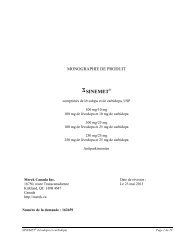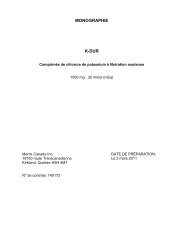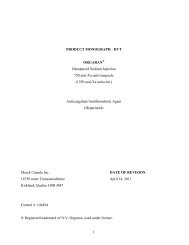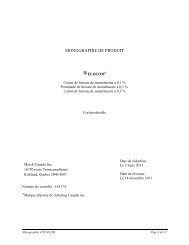PRODUCT MONOGRAPH
PRODUCT MONOGRAPH
PRODUCT MONOGRAPH
You also want an ePaper? Increase the reach of your titles
YUMPU automatically turns print PDFs into web optimized ePapers that Google loves.
ACTION AND CLINICAL PHARMACOLOGY<br />
Mechanism of Action<br />
Testosterone undecanoate, an orally active testosterone preparation, is a fatty acid ester of the<br />
natural androgen testosterone. Unlike other oral testosterone preparations, testosterone<br />
undecanoate is able to by-pass the liver via the lymphatic system and is therefore orally<br />
bioavailable.<br />
Therapy with testosterone undecanoate increases plasma levels of testosterone and its active<br />
metabolites, leading to a regular therapeutic effect. In eugonadal men, peak testosterone levels<br />
are reached approximately 4-5 hours after ingestion, returning to basal levels after about<br />
10 hours. In volunteers and hypogonadal men, 77-93% of an orally administered dose of<br />
testosterone undecanoate was excreted in the urine and faeces within 3 to 4 days. 1<br />
Andriol ® (testosterone undecanoate dissolved in a mixture of castor oil and propylene glycol<br />
monolaurate) has been found to exhibit comparable testosterone bioavailability to Andriol ®<br />
(testosterone undecanoate in oleic acid).<br />
Andriol ® delivers physiologic amounts of testosterone, producing circulating testosterone levels<br />
that approximate normal levels (e.g. 10.4-34.6 nmol/L [300-1000 ng/dL]) seen in young healthy<br />
men.<br />
Pharmacodynamics<br />
Testosterone and Hypogonadism: Testosterone and dihydrotestosterone (DHT), endogenous<br />
androgens, are responsible for normal growth and development of the male sex organs and for<br />
maintenance of secondary sex characteristics. These effects include the growth and maturation<br />
of the prostate, seminal vesicles, penis, and scrotum; the development of male hair distribution,<br />
such as facial, pubic, chest, and axillary hair; laryngeal enlargement; vocal cord thickening;<br />
alterations in body musculature; and fat distribution.<br />
Male hypogonadism results from insufficient secretion of testosterone and is characterized by<br />
low serum testosterone concentrations. Symptoms associated with male hypogonadism include<br />
decreased sexual desire with or without impotence, fatigue and loss of energy, mood depression,<br />
regression of secondary sexual characteristics, and osteoporosis. Hypogonadism is a risk factor<br />
for osteoporosis in men.<br />
General Androgen Effects: Drugs in the androgen class also promote retention of nitrogen,<br />
sodium, potassium, phosphorus, and decreased urinary excretion of calcium.<br />
Androgens have been reported to increase protein anabolism and decrease protein catabolism.<br />
Nitrogen balance is improved only when there is sufficient intake of calories and protein.<br />
Androgens have been reported to stimulate the production of red blood cells by enhancing<br />
erythropoietin production.<br />
Androgens are responsible for the growth spurt of adolescence and for the eventual termination<br />
of linear growth brought about by fusion of the epiphyseal growth centers. In children,<br />
exogenous androgens accelerate linear growth rates but may cause a disproportionate<br />
ANDRIOL ® (testosterone undecanoate capsules) Page 11 of 26






